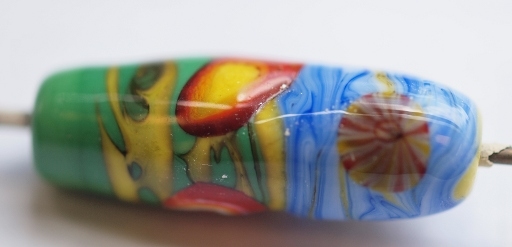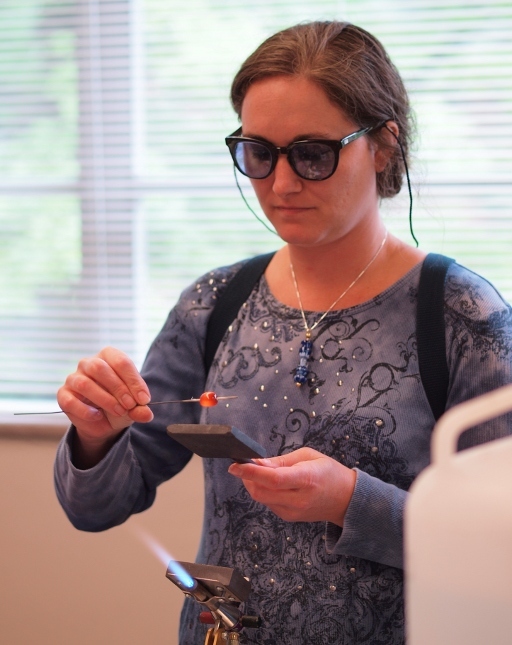Sheila Morley kindly consented to demonstrate placing murrine—this after she'd taught us how to make murrine in a prior class—forget that, people said, just teach how to apply the ones we've already got without smearing them all over!
Now to be perfectly honest here, I didn't really watch Sheila's demo very carefully, because I was either pricing stuff for Bead&Button (ugh) or photographing her (fun!) However, we both took the same Loren Stump intensive, and it's not as if I haven't been wrestling with this problem a great deal on my own, what with my commitment to put sig cane murrine on my sculptural heads.
And I did overhear some of her instructions, even while head-down angsting over the proper price for tigers. (The fabulous Joy Cichewicz will also have her lions and tigers and bears at our table, and as she's much more expert, both at making and selling tigers, I felt my prices ought to align with hers;)
So, getting away from the blatant sales blurb, what about Sheila's demo? Well, as I (re)discovered by trial and error, the secret to crisp murrina application is, as Sheila noted, a really soft, hot spot on the base bead, and a relatively cold (as in, just warm enough not shatter all over the damn place) murrina. Obviously this is far more of a challenge for Sheila, who applies honking big (and thick) murrine to her beads, as opposed to the thin little 2–3mm sig cane murrine I typically use; but the principle is the same.
Some people like to preheat them, on the metal part of their torchtop marver, a hotplate, or (I'm thinking this would be ideal) a cup-warmer. The latter is small and inexpensive. Myself, I've only ever used these to dry pmc, but I think they'd be a good, compact experiment to try. Because my murrine are so small, I just pick it up with tweezers[1] wave it a bit in the flame while simultaneously superheating the section of bead where I wish to place it.
Now, given that I make hollow beads I do get a bit of distortion from shoving a hard lump into very soft glass, but at least my murrina stays nice and crisp. Next problem: Murrine balling. Heat your cylindrical (disk-shaped) murrina even a little bit, and what does it do? That's right, it balls up into a cabochon (half-round) shape—very annoying. There doesn't seem to be much you can do to avoid this except heat it carefully and slowly, while patting it down (I like to use a metal, rather than graphite, tool for this job, because it leaches more heat and thus works faster.)

It's just a demo. Roughly 2" long, this Italian-glass barrel bead shows a variety of Sheila's artist-made murrine applications. bead, photo 6jun2010.
Another thing you can do is spot case your murrina. My very first teacher, Preggy Priolozny, who incorporates commercial murrine in her lovely dichro-core heart beads, is a past mistress at this technique. Again, the murrina (& thus, the base bead into which it's now inserted) needs to be relatively stiff, and the casing glass soft. Of course if it's really hot it will dump that heat into your base glass, causing the dreaded smearing. As with so many other things in life, you want to use just as much heat as is needed to get the job done, and no more.
Really, just about every time something is going wrong in my lampworking, it's generally because I'm using too much heat for the job, and the extra is going places where I don't want it.
Or, put another way: patience is a virtue, especially when working glass!
[1]curse when I drop it, pick up another, then
Unless otherwise noted, text, image and objects depicted therein copyright 1996--present sylvus tarn.
Sylvus Tarn